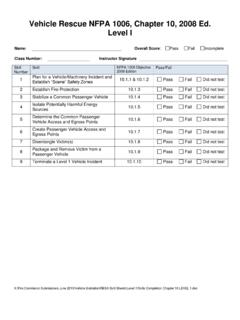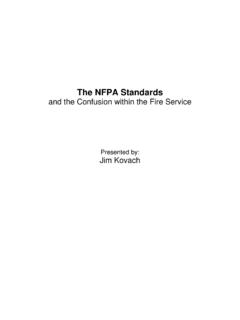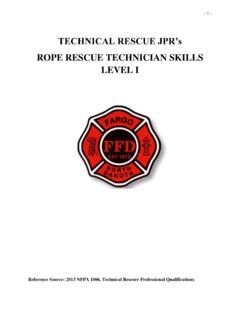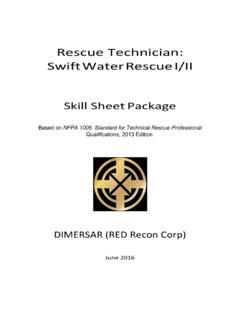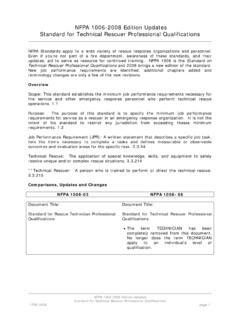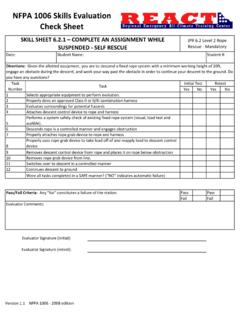Transcription of FORMATTED- Rescue Tech and NFPA standards
1 1 The Rescue technician and nfpa standards Recently I was tasked with the challenge to review and update the technical Rescue programs as the new technical Rescue coordinator for the Georgia Fire Academy. My background in teaching rope Rescue gave me the technical knowledge I needed, but technical knowledge was not enough to develop a plan for statewide training. Technical Rescue , in general, is a high risk and low frequency occurrence in the Rescue industry. Since there are never enough hours in the day to train on all the things that firefighters are expected to know, I began to look for some guidance to see what is expected of the technician .
2 So of course I looked to the industry standards that coined the term to see what was expected of rescuers. After many conversations and receiving conflicting interpretations of what a technician is expected to do, surrendered to the realization that I would have to reads the standards myself. Now realizing that reading the oh-so-suspenseful booklet adorned in red, could be as exciting as watching the grass grow, I decided to suck it up and dive into the material. Confused at what seemed to be more conflicting information, I immediately figured out that I couldn t jump to the end of the standard to fine a fairytale ending.
3 Instead I d have to start at the very beginning. Once I things became clear. I was trying to make the wrong standard fit with our programs! Each standard is directed to a different audience. Perhaps you too have had difficulty trying to decipher what standard you should reference. If so, this overview of nfpa standards 1670, 1006, and 1983 may help save a lot of time and confusion. However, if you looking for the cure for insomnia, by all dive into the original documents yourself. nfpa Technical Rescue standards National Fire Protection Association ( nfpa ) is committed to advocating consensus codes and standards and providing research and education for fire and related safety issues.
4 A nonprofit membership organization, nfpa has over 65,000 members and is staffed by over 5,000 volunteers. Many of these volunteers are part of technical committees. These committees work hard to develop standards which prompt a high level of safety to which all fire service personnel and organizations are held accountable. Currently there are three (3) nfpa standards which directly applied to technical Rescue efforts that should be addressed as part of becoming a Rescue technician . An overview of whom these standards are meant to address, and the intent of each standard, is vital in knowing which standard to reference for specific details when needed.
5 Each standard is dynamic, in that it evolves and changes with each revision. The information in this article is based upon the most current version of the standard. Future revisions may change, or address additional areas of interest, and it is up to each person and department to revisit standards as they evolve. nfpa 1670 Prepared by the Technical Committee on Technical Rescue , and issued by the nfpa standards Council, the nfpa 1670 document addresses standards on Operations and Training for Technical Search and Rescue Incidents. Originally, developed in 1994, the most recent version if this standard was approved and adopted in January 2004.
6 Each nfpa standard identifies a scope, or whom it applies to, and a purpose. The scope of this standard shall identify and establish levels of functional capability for conducting operations at technical search and Rescue incidents while minimizing threats to rescuers ( ). This standard goes on to state, the requirements of this standard shall apply to organizations that provide response to technical search and Rescue ( ) 2 Awareness Operations tech That means that that if your organization, whether it is EMS, Law Enforcement, Emergency Management agencies, or any group that responds to certain technical Rescue incidents, whether they respond independently or in conjunction with the Fire Department, should prepare to at least the minimum level of functional capability.
7 The scope of nfpa 1670 is to IDENTIFY and ESTABLISH levels of functional capabilities for agencies that provide response. The purpose, or the intent of nfpa 1670 is to assist the authority having jurisdiction (AHJ) in: assessing a technical search and Rescue hazard within the response area, to identify the level of operational capability, and to establish operational criteria. ( ) Now some of you might be asking WHO is the AHJ? This terminology is found in throughout nfpa 1670 and many nfpa documents. The AHJ refers to the organization, committee, or person that makes the decision and enforces the rules for your team, department or agency.
8 The AHJ is responsible for approving equipment and materials, and also in charge of implementing departmental procedures. The purpose of nfpa 1670 is to assist the decision making personnel for an organization to assess preparation and response readiness for a technical search and Rescue incident. nfpa 1670 goes on to state, the AHJ shall establish levels of operational capability needed to conduct operations at a technical search and Rescue incidents safely and effectively, based on: hazard identification risk management training level of personnel, and availability of internal and external resources ( ) By assessing these criteria, the AHJ can decide at which level it wants to be able to perform operations at a scene, and shall establish written standard operating procedures consistent with the chosen level.
9 ( ) There are three (3) identified levels of operational capabilities for a technical search and Rescue incident. technician Level- This level represents the capability of organizations to respond to technical search and Rescue incidents, to identity hazards, use equipment, and apply advanced techniques specified in this standard necessary to coordinate, perform, and supervise technical search and Rescue incidents ( ) Operations Level- This level represents the capability of organizations to respond to technical search and Rescue incidents and to identify hazards, use equipment and apply limited techniques specific in this standard to support and participate in technical search and Rescue incidents ( ) Awareness Level- This level represents the minimum capabilities of organizations that provide response technical search and Rescue incidents ( ) The minimum training for an organization shall be at the awareness level ( )
10 3 nfpa 1670 identifies the need for a certain level of training, proper documentation, SOP s, hazard identification, risk assessment, incident response planning, equipment, safety, fitness, etc. The various levels of preparedness within each of these areas, is what should be assessed for each organization. Based on a needs assessment, the AHJ shall provide the proper support to function to the planned level of operation. Since the specialized needs to operate at the highest level of operational capabilities are difficult to maintain, the AHJ can choose to operate at a particular level for discipline X, and then a DIFFERENT level of operations for discipline Y.
